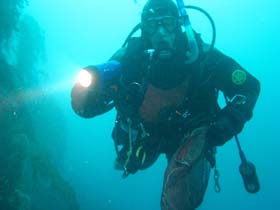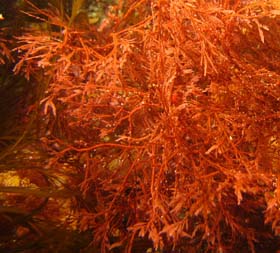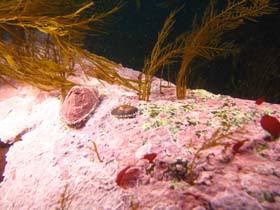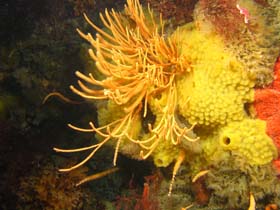
Recently I began watching the new Star Wars trilogy and there are many references to bacterial communities (metachlorian counts) in Jedis and Sith lords because they are the source of the ‘force’. This got me thinking… bacterial communities are incredibly common in the marine environment on rocks and algae, on animals, and in the water column. This is a really cool aspect of the marine environment that has become a popular area of research in marine ecology since quorum sensing was discovered. Quorum sensing is the name of a method of communication in bacterial communities where certain signaling molecules (peptides or sugars) coordinate decentralized communities in making ‘group decisions’.
A really good example of quorum sensing is found in a Hawaiian squid where high levels of bacteria in organs called photophores cause bioluminescence in the squid. In a sense, the high levels of bacteria in Anakin Skywalkers blood gave him the power to quorum sense with the universe. (Julie, imaged right with her light saber/dive light might also have high levels.) Who knew George Lucas was into marine biology. Nerdy? Maybe, but it’s a great introduction to very complex environment that is the marine benthos and one of my experiments:
Episode #1: A New Hope
Microbial communities that develop on hard substrates are called biofilms. You may have heard of them because they are a problem in medicine when they form on catheters and other invasive medical technology. In the marine environment can they grow on everything (with few exceptions) and often facilitate settlement and growth of algal spores (seeds) or invertebrate larvae (early life stages). Biofilms can actually attract various baby marine organisms to settle in certain locations and the diverse array of bacteria species within the films can provide nutrients and CO2 or O2 for the organisms that have settled there, fostering the next generation in the marine community.In this Schoenrock version of Episode #1, the bacteria are basically fostering the new hope for the marine community.
Episode #2: The Empire Strikes Back

Sometimes algae or invertebrates can actually prevent settlement of bacterial communities that may otherwise hinder their health. Some examples are a red alga that is common in New Zealand, Delisea pulchra (and we find here – see my underwater image left), and a suite of sponge species from Antarctica. Delisea pulchra actually produces chemical compounds that prevent the bacterial communities from communicating, therefore inhibiting ‘swarming’ or establishment of biofilms on the alga. The sponges from Antarctica produce antibiotic chemistry which prevents growth of bacteria on the sponge. These two mechanisms of inhibiting bacteria community formation describe the chemical ecology of the community. Chemical ecology is the study of how organisms use chemical signals to communicate amongst community members or with the environment.
Episode #3: Return of the Jedi
A lot of the research that we are undertaking this year revolves around climate change and how it will impact the marine environment. This theme has been underscored in my UAB in Antarctica’s team mates’ posts and will continue as a common thread weaving these posts together. In previous years Team UAB in Antarctica, including me, has done a lot of research on the chemical ecology of the algae and invertebrates of the western Antarctic Peninsula. In addition to my ocean acidification experiments, I am working on an another experiment which attempts to determine whether certain species of coralline algae affect invertebrate larval settlement in Antarctica through chemical signaling of either the algae or the bacterial communities on their surface. See another of my underwater pics right of baby brown algae (Demsarestia menziesii) settled on on the reddish coralline algae that settled as a baby and overgrew its small rock home surface.

In many marine communities coralline algae and the biofilms that specifically grow on them have been shown to affect invertebrate larval settlement. Some species attract coral larvae and there have been attempts to use algae extracts to restore dying reefs by creating a ‘flypaper’ for the larvae. My experiment attempts to determine whether community interactions that are common on coral reefs are also present in the Antarctic benthos. Last year, I anchored numerous small plexiglass squares- settlement plates as a marine ecologist would say- at various underwater sites to see what creatures algal and animal claimed them for home over the winter.
So far I have been to collect settlement plates from the shallow depths at my two sites. The invertebrate settlement is much more prolific than I expected based on my pilot experiments. Being a phycologist or algae specialist, it’s difficult for me to determine what the little dudes are without a lot of bookwork and consultation from other folks here who are into invertebrates and what the heck their baby stages might look like. I suspect many of the unrecognizable life forms might grow up to be solitary 'string bead' corals or sponges like those I photographed shown left.

Whatever the life form, animal or algal, I’m excited to see whether the force is strong in Antarctic benthic communities. Stay tuned for my next episode coming....
In the meantime, may the force be with you.
Still seeking answers? Send a hyperspace commo to